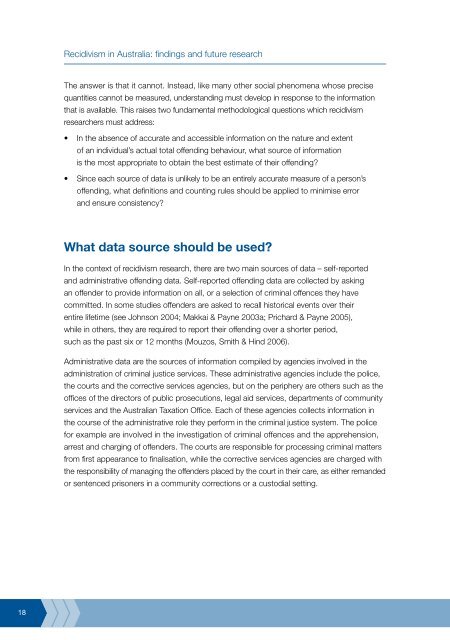Recidivism in Australia : findings and future research - Australian ...
Recidivism in Australia : findings and future research - Australian ...
Recidivism in Australia : findings and future research - Australian ...
Create successful ePaper yourself
Turn your PDF publications into a flip-book with our unique Google optimized e-Paper software.
18<br />
<strong>Recidivism</strong> <strong>in</strong> <strong>Australia</strong>: f<strong>in</strong>d<strong>in</strong>gs <strong>and</strong> <strong>future</strong> <strong>research</strong><br />
The answer is that it cannot. Instead, like many other social phenomena whose precise<br />
quantities cannot be measured, underst<strong>and</strong><strong>in</strong>g must develop <strong>in</strong> response to the <strong>in</strong>formation<br />
that is available. This raises two fundamental methodological questions which recidivism<br />
<strong>research</strong>ers must address:<br />
•<br />
•<br />
In the absence of accurate <strong>and</strong> accessible <strong>in</strong>formation on the nature <strong>and</strong> extent<br />
of an <strong>in</strong>dividual’s actual total offend<strong>in</strong>g behaviour, what source of <strong>in</strong>formation<br />
is the most appropriate to obta<strong>in</strong> the best estimate of their offend<strong>in</strong>g?<br />
S<strong>in</strong>ce each source of data is unlikely to be an entirely accurate measure of a person’s<br />
offend<strong>in</strong>g, what def<strong>in</strong>itions <strong>and</strong> count<strong>in</strong>g rules should be applied to m<strong>in</strong>imise error<br />
<strong>and</strong> ensure consistency?<br />
What data source should be used?<br />
In the context of recidivism <strong>research</strong>, there are two ma<strong>in</strong> sources of data – self-reported<br />
<strong>and</strong> adm<strong>in</strong>istrative offend<strong>in</strong>g data. Self-reported offend<strong>in</strong>g data are collected by ask<strong>in</strong>g<br />
an offender to provide <strong>in</strong>formation on all, or a selection of crim<strong>in</strong>al offences they have<br />
committed. In some studies offenders are asked to recall historical events over their<br />
entire lifetime (see Johnson 2004; Makkai & Payne 2003a; Prichard & Payne 2005),<br />
while <strong>in</strong> others, they are required to report their offend<strong>in</strong>g over a shorter period,<br />
such as the past six or 12 months (Mouzos, Smith & H<strong>in</strong>d 2006).<br />
Adm<strong>in</strong>istrative data are the sources of <strong>in</strong>formation compiled by agencies <strong>in</strong>volved <strong>in</strong> the<br />
adm<strong>in</strong>istration of crim<strong>in</strong>al justice services. These adm<strong>in</strong>istrative agencies <strong>in</strong>clude the police,<br />
the courts <strong>and</strong> the corrective services agencies, but on the periphery are others such as the<br />
offices of the directors of public prosecutions, legal aid services, departments of community<br />
services <strong>and</strong> the <strong>Australia</strong>n Taxation Office. Each of these agencies collects <strong>in</strong>formation <strong>in</strong><br />
the course of the adm<strong>in</strong>istrative role they perform <strong>in</strong> the crim<strong>in</strong>al justice system. The police<br />
for example are <strong>in</strong>volved <strong>in</strong> the <strong>in</strong>vestigation of crim<strong>in</strong>al offences <strong>and</strong> the apprehension,<br />
arrest <strong>and</strong> charg<strong>in</strong>g of offenders. The courts are responsible for process<strong>in</strong>g crim<strong>in</strong>al matters<br />
from first appearance to f<strong>in</strong>alisation, while the corrective services agencies are charged with<br />
the responsibility of manag<strong>in</strong>g the offenders placed by the court <strong>in</strong> their care, as either rem<strong>and</strong>ed<br />
or sentenced prisoners <strong>in</strong> a community corrections or a custodial sett<strong>in</strong>g.















